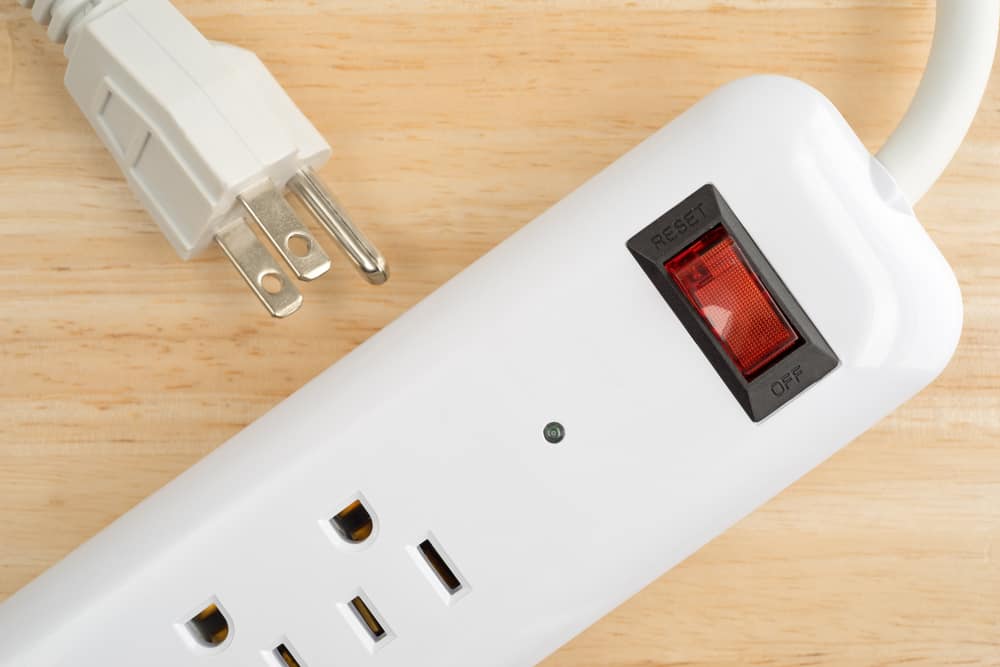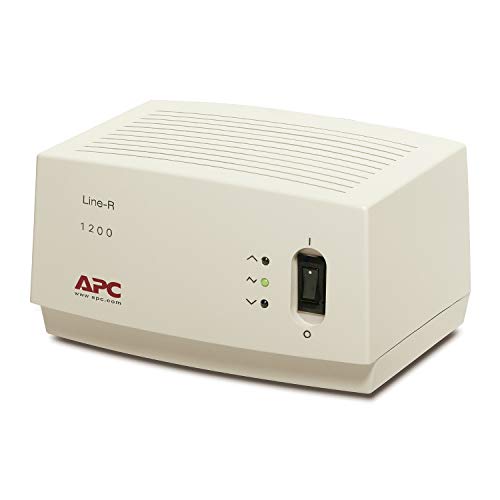
If you live in an area with frequent voltage fluctuations and blackouts, you might fear for the safety of your new PC or the critical data you have on it.
Maybe you live in an old house with a few outlets that don’t provide reliable power, and you need more outlets that won’t make your circuit breaker trip or damage your PC.
These might sound like good reasons to buy a surge protector, but do you really need one?
This article discusses the benefits of using a surge protector and tips for choosing one that suits your needs.
It also introduces some other protection you can consider.
Do I Need A Surge Protector For My PC?

A surge protector is highly recommended as it can protect the power-sensitive components inside your PC from sudden voltage spikes caused by accidents, power-hungry appliances, poor wiring practices, and lightning.
It directs the excess voltage to the ground so that your electronics don’t suffer a shock.
Although most modern PC components have some level of built-in surge protection, any incident that trips your circuit breaker can also fry your PC parts.
Without a surge protector, the chance of you losing your digital data or the whole system with a strong surge is very high.
The PSU and motherboard are the most vulnerable as they’re the first components through which electricity flows.
What Is a Power Surge and How Does It Affect My PC?

The power voltage in a typical wall outlet in the US is 120 volts, but it can safely fluctuate between 0 and 169 volts.
Sometimes, the steady voltage flow gets disturbed and goes over 169 volts.
This short, fast increase in voltage is called a power surge.
Although the most potent cause of a surge is a lightning strike, a malfunction in a nearby power line is the most common.
Turning on or off a high-powered electrical appliance in your house can also cause a voltage surge.
When a surge happens, the power entering a PC or any other electrical device goes above its standard operating voltage, and the heat generated due to the excessive current can damage its sensitive components.
Specifically, the capacitors receive more electrical charge than they can handle, causing a short circuit.
Although a power surge lasts for about a fraction of a second, it can severely damage your PC.
Therefore, if you want to keep your PC safe, you need to use some protection.
One way of protecting your PC or other electronic devices from a power surge is using a surge protector.
How Does A Surge Protector Protect My PC?
KMC 6-Outlet Surge Protector Power Strip 2-Pack, 900 Joules, 4-Foot Extension Cord, Overload Protection, Black
To protect your PC from the damage caused by a power surge, you should either prevent the power overflow—which is impossible—or prevent the excess voltage from reaching your device.
A surge protector protects your PC from voltage inconsistencies by redirecting the unsafe power and only allowing a safe amount of energy to enter your device.
Below, we’ve listed some of the benefits of using a surge protector:
1. Saves The Motherboard

The motherboard is the main platform that connects all your PC parts.
It’s the central hub that allows communication among all the other components and peripherals.
Therefore, if the motherboard is dead or damaged, it means the death of your PC.
Although a high-quality motherboard doesn’t fail easily, it’s sensitive to overheating.
A strong power surge can fry it as well.
If the motherboard is damaged, you need to replace it, and you’ll have to search for one compatible with all the other components.
This process can be rather unpleasant and usually won’t have a happy ending.
There’s really no way of telling which part will get damaged if your PC receives an electric shock.
One of the easiest ways to save yourself from extra effort and stress is to use a good surge protector.
2. Keeps Your Data Safe

The hard drive is where all your digital content lives on your computer.
Any damage to the hard drive can have severe consequences, including the permanent loss of your data.
Damage to a hard drive can result from a physical shock or voltage spikes.
Hard drives and 2.5-inch SSDs have dedicated connectors from the PSU, whereas NVME M.2 drives are mounted on the motherboard.
A power surge can’t affect the mechanical components inside your hard drive.
Still, it can kill the control board on the bottom and the circuitry.
Although you may be able to recover the data, your chances will be slim, and you still have to replace the damaged hard drive with a new one.
Therefore, if you want to keep your data safe, use a surge protector to detect excess electricity and save your hard drive from damage.
3. Protects Your Battery And Charger

Your laptop needs an appropriate charger and a healthy battery that can keep the charge.
If a power surge happens when your laptop is plugged in, both the battery and the charger will be in great danger.
If a surge harms either component, you may not be able to turn on your laptop.
Alternatively, the battery may die, forcing you constantly to be plugged in when you need to use your computer.
Therefore, consider keeping your laptop’s battery safe with a surge protector if you want to stay portable.
4. Extends Your PC’s Overall Lifespan

While strong power surges can kill your PC, weak but frequent voltage increases will gradually damage the sensitive components and reduce your PC’s lifespan.
A surge protector can protect your PC against surges of any magnitude and from sudden shutdowns caused by power outages.
These total outages can result in file or drive corruption and reduce your PC’s lifespan.
If you plug your PC into a standard surge protector, it’ll be safe for a longer period, and you won’t have to pay for costly repairs or even replacements later on.
Do All PCs Need Surge Protection?

Although the power supplies in most computers provide some protection against short and insignificant power fluctuations, they’re not strong enough to shield your PC against solid surges.
Even the surge protectors themselves are not immune to a strong power surge.
You can imagine how easily your PC’s electronic components, even the power supply itself, can be damaged.
Therefore, it’s better to use a quality surge protector and plug all your PCs and computer gear into it, no matter how new or advanced.
Do Surge Protectors Affect PC Performance?

A surge protector’s job is to block the excess power that can damage your PC components, but it doesn’t interfere with the standard power flow required for your PSU to run.
Therefore, using a surge protector won’t affect your PC’s overall performance.
However, if you have your router going through a surge protector, your internet might slow down a bit, or you may experience connectivity problems if there’s a surge.
To be sure what’s best for you, do a few before and after tests.
This will help you decide if you should connect your cable and phone line to a surge protector or connect your lines directly to a cable modem.
Do Surge Protectors Waste Power?

A surge protector’s only job is to monitor the electricity flow and absorb the extra voltage if a surge happens.
Therefore, it doesn’t drain any power itself.
However, connected devices, including your desktop computer and laptop, constantly use electricity, even when you’re not using them.
This power consumption is called “standby power” or “vampire power.”
Although one device won’t waste much power, the energy drain from all your appliances combined can account for about 10 to 20% of your electricity bill.
Surge protectors can minimize the wasted power in your house and save some money.
They’re also very convenient.
Instead of unplugging numerous devices one by one, you can turn off your surge protector and stop the power flowing to any appliance connected to it.
Don’t worry about the protection because no electricity reaches your devices when you flip the surge protector’s switch off.
Also, turning off your surge protector when you’re not using the devices hooked to it can prevent overheating and dust accumulation, so it’ll last longer.
Are Surge Protectors And Power Strips The Same Thing?
KMC 6-Outlet Power Strip, Overload Protection, 3-Foot Cord, White
Although we sometimes hear surge protectors and power strips used interchangeably, you should know that they’re not the same thing.
Both power strips and surge protectors will give you extra outlet space.
Plus, they both come at relatively affordable prices, and you can find one for less than 20 dollars.
However, the latter can also guard any electronic device connected to it against voltage fluctuations.
If the package doesn’t say whether the device is a surge protector or a power strip, search it for a joules rating, as only surge protectors have them.
This number is an indicator of the surge protector’s lifespan.
How Long Can I Use A Surge Protector?

A working surge protector can keep your PC safe and prevent data loss, but sometimes, you won’t know if it is working.
Check the surge protector frequently, especially after a power surge or outage, to ensure your electronic devices are effectively protected.
The lifespan of a surge protector is about three to five years in normal areas with little or no dangerous power fluctuations.
On the other hand, if your area is subject to frequent blackouts or brownouts, changing your surge protector every two years or even sooner is better.
However, surge protectors are either destroyed or weakened to a point where they can’t protect your devices anymore when hit by a powerful surge.
Therefore, if you want maximum protection for your devices, replacing the protector after every severe power surge might let you avoid high costs in the future.
What Should I Look For When Choosing A Surge Protector?
Surge Protector Power Strip - Nuetsa Flat Plug Extension Cord with 8 Outlets and 4 USB Ports, 6 Feet Power Cord (1625W/13A), 2700 Joules, ETL Listed, Black
When choosing a surge protector, there are several factors you should check.
1. Joules Rating
This factor tells you how much energy the surge protector can absorb and shows how long it can protect your appliances.
The higher the joules rating, the longer the lifespan of your protector.
You should keep in mind that the number written on the package will deplete over time.
Sometimes one strong surge is enough to exceed the number of joules your surge protector can take, but it can take longer for little surges to do so.
Some surge protectors have lights or alarms that will tell you when it’s time to replace them.
If you want sound protection for your PC, look for surge protectors with a rating of 1,000 joules or more.
2. Clamping Voltage
This number tells you how much voltage can trigger the surge protector.
This number can be somewhere between 330 volts and 4,000 volts.
The lower the clamping voltage, the better the protection.
Even if your protector has enough joules, with a high clamping voltage, even small surges can damage your PC.
3. UL Safety Rating
UL is an independent organization that tests the safety of electronic and electrical devices.
A UL listing shows that you can trust a surge protector.
Surge suppressors should be UL 1449 listed.
A surge protector that doesn’t come with a UL rating probably won’t protect your computer at all.
4. Number Of Ports
Choose a surge protector that provides the number of ports you need, especially if the space where you want to use it doesn’t have enough outlets.
Keep in mind that you should not overload a surge protector as it might have unpleasant consequences like a circuit breaker trip.
Heating products like hair dryers, toasters, or space heaters need more power than other devices.
You’ll be safe if you only connect one of these power drawing devices to each surge protector.
Can A Surge Protector Cause Problems?

Although surge protectors should keep your electrical devices safe, they can become a serious fire hazard if not used properly.
As appliances connected consume power even when turned off, you should switch off your surge protectors when not in use.
Also, never overload a surge protector by connecting too many power-hungry devices, such as heaters, air conditioners, and refrigerators.
Instead, use more surge protectors and only connect one of these high-capacity appliances to each.
Other Ways To Protect Your PC From A Power Surge

Although surge protectors are usually effective if used correctly, there are other more substantial alternatives if you’re obsessive about protecting your PC.
1. Line Conditioner
Tripp Lite LC2400 Line Conditioner 2400W AVR Surge 120V 20A 60Hz 6 Outlet 6-Feet Cord
Unlike a surge protector, a line conditioner protects your PC from both over-voltage and under-voltage.
If the voltage is too low, the line conditioner increases it to the proper range.
When the voltage is too high, it clamps it down to reach the required amount.
A line conditioner also removes adverse electrical noises coming from devices such as motors and radios.
Line conditioners are more expensive than surge protectors, but the extra money is worth the better protection your PC will get.
2. AVR 
APC Automatic Voltage Regulator, LE1200, Line-R 1200VA
An automatic voltage regulator (AVR) is a device that provides a constant voltage level to your PC by turning fluctuating voltage levels into stable voltage levels.
In other words, it regulates the surges that are coming from your wall outlet to your PC.
An AVR can work as a surge protector, but it can only provide about 300 joules of surge protection compared to the 1,000+ joules of a decent surge protector.
Although both AVRs and surge protectors maintain a stabilized flow of current to your appliances, they do it in different ways, and you can use them together for optimal results.
3. UPS
CyberPower CP1500AVRLCD Intelligent LCD UPS System, DISCONTINUED * SEE NEW UPDATED MODEL CP1500AVRLCD3 *
An uninterruptible power supply (UPS) is a battery backup used for memory-based hardware.
A UPS can give you an extra level of safety for both the delicate hardware components in your PC and the data you haven’t saved yet.
The price of a quality UPS might be relatively higher than the protectors mentioned above.
If you regularly do critical work on your PC or live in an area with frequent power outages, buying a UPS might be a good investment.
NEXT: Is Building A PC Hard? (Everything To Know)






























